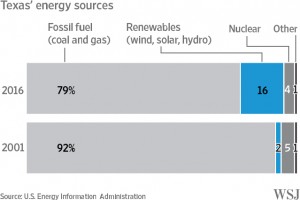from The Wall Street Journal,
8/29/16:
The Lone Star state has added more wind-based capacity than any other, as part of an aggressive energy diversification that seeks to skirt ideological land mines.

On a blustery February night, the Texas electricity market hit a milestone. Nearly half the power flowing onto the grid came from wind turbines, a level unimaginable a decade ago in a place better known for its long romance with fossil fuels.
The Lone Star state still embraces its oil and gas, leading a revolution in innovative “fracking” technology. Yet an equally startling energy bonanza here has gone almost unnoticed—the rise of renewables.
Texas has added more wind-based generating capacity than any other state, with wind turbines accounting for 16% of electrical generating capacity as of April. Now Texas is anticipating a huge surge in solar power.
At a time when debate is raging between political parties over climate change, and critics charge that “green energy” is little more than a government creation, Texas has taken an approach that works within the state’s free-market-based electricity system. State officials say wind and solar are almost certain to play a significant and growing role in the state’s energy future even when federal subsidies decline in coming years.
“We’re in chapter three of a 50-chapter book,” says Joel Mickey, director of market design and development for the state’s electric-grid operator, the Electric Reliability Council of Texas, or ERCOT.
Elsewhere, most of the renewable growth is coming from blue states. California is the leader in solar power with more systems cranking out electricity, right now, than what Texas hopes to add in the nextfive to 10 years. New York finalized a plan Aug. 1 to get to half its power from zero-emission sources by 2030, with big goals for offshore wind turbines. And wind farms provided Iowans with nearly a third of their electricity last year—the largest percentage of any state. Texas remains one of the few reliably Republican states to jump on the bandwagon.
Its transformation hasn’t come without risks. In the early days, the state government charged electric-system users billions of dollars to build transmission lines needed to get power from windy West Texas to power-hungry cities. There was also a steep learning curve. Renewable power is only available when the wind is blowing or the sun is shining. It can’t be dispatched precisely when it’s needed but just when it’s available, meaning grid officials have had to become obsessive about anticipating weather. Efficient battery-storage technologies remain elusive.
Then there is the issue of subsidies. Wind projects get hefty federal payouts whenever they generate electricity. At auctions, this means they can sometimes pay the state to take their electricity and still make money, undercutting the business model of fossil-fuel generators.
Some critics worry this could lead power companies to decommission fossil-fuel plants prematurely—even though some fuel sources such as natural gas and coal are arguably cheaper these days.
The roots of Texas’ renewables boom go back to 1999, when then-Gov. George W. Bush and a Republican-dominated legislature overhauled the Texas power market. The free market-oriented deregulation broke the grip of most monopoly utilities that controlled generation, transmission and retail sales of electricity and introduced competitive auctions for wholesale power.
The deregulation plan, which Mr. Bush signed just days after announcing he would run for the presidency, also included a government-imposed requirement to have at least 2,000 megawatts of renewable generating capacity by 2009.
Texas blew past that goal in 2005. Then Gov. Rick Perry, also a Republican and no fan of government intervention, raised the goal to 10,000 megawatts by 2025. Texas hit that target in 2011 and kept going. In April, there was more than 19,000 megawatts of renewable capacity, according to the U.S. Department of Energy, cranking out enough power for nearly 4 million Texas homes.
Texas officials didn’t invoke global warming to sell the program. Instead, they touted renewable energy as a consumer-choice issue, a jobs producer and a way to pump more money into rural counties.
More From The Wall Street Journal (subscription required):





